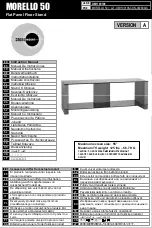
EMR User's Guide
High Density Modular Audio Router (AES, Analog, MADI, TimeCode, Data)
Page 18
Revision 1.8
COMPONENT OVERVIEW
Component
Description
Voltage Status LEDs
This set of LEDs are amber in color and should always be ON
Ethernet 1 LED
This LED is green in color and flashes when there is activity on
Ethernet port 1
Ethernet 2 LED
This LED is green in color and flashes when there is activity on
Ethernet port 2
TDM 1
This LED is green in color and flashes when a valid TDM signal is
detected on TDM input 1 and is solid when it is the primary TDM
TDM 2
This LED is green in color and flashes when a valid TDM signal is
detected on TDM input 2 and is solid when it is the primary TDM
Bank Select Push
Button
Selects the bank of inputs that are being monitored by the Audio
Present LEDs
CH 1-24 LED
This LED is green in color and indicates that inputs 1 to 24 are
currently being monitored by the Audio Present LEDs
CH 25-48 LED
This LED is green in color and indicates that inputs 25 to 48 are
currently being monitored by the Audio Present LEDs
CH 49-72 LED
This LED is green in color and indicates that inputs 49 to 72 are
currently being monitored by the Audio Present LEDs
CH 73-96 LED
This LED is green in color and indicates that inputs 73 to 96 are
currently being monitored by the Audio Present LEDs
Audio Present LEDs
This set of LEDs are green in color and indicate the presence of
audio on each respective input
Run/Upgrade Jumper
This jumper is used to place the module in upgrade mode when
upgrading the firmware
Reference 1 LED
This LED is amber in color and indicates the presence of a valid
reference on input 1. It will flash rapidly if reference is present and
slowly if it is the primary reference
Reference 2 LED
This LED is amber in color and indicates the presence of a valid
reference on input 2. It will flash rapidly if reference is present and
slowly if it is the primary reference
Reset Button
This button resets the module
Headphone Jack
This jack allows a user to monitor audio signals from a pair of
headphones
Table
2-6: Description of EMR-OP96 (48)-AESU (B) Card Edge
2.2.2.5. Configuration and Monitoring Menu
EMR-OP96 (48)-AESU (B) contains configuration and monitoring menu that allows the user to change
some internal settings of the device and also to monitor various components on the card.
The configuration and monitoring menu can be accessed using either Telnet session or serial connection.
Once gained access to the main menu, use the numbers beside the items to set the value. Follow the on
screen instructions to set the value of the parameter, save and exit the configuration.
















































